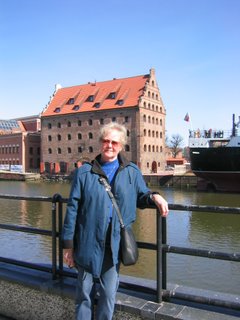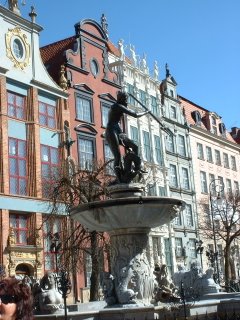More Poland Travelogue
Poland Tour Day 2: April 1
Breakfast the next morning in the hotel was wonderful. It was in a beautiful room, all light colored marble, chandeliers and mirrors. They were cooking omelets to order. We were taking the 8:50 train to Malbork Castle. We decide to walk to the station, as it was close by, and not raining. Unfortunately most of the escalators were out of order so we humped our bags up & down stairs to get to the right platform. We got the train, found the right car, and got into our first-class compartment. Settled in for the 3+ hour ride. The countryside was a bit bleak, soggy with rain and scrubby with brown winter grass. We saw some snow still in the trees. We piled out of the station at Malbork, having a bit of trouble getting our bags down the steep steps off the train. But our driver Andrew met us, he pointed in the right direction and we got into the Mercedes Mini-bus. Very spacious, lots of tall windows. It was a quick ride to the castle. We disembarked, and marveled at the sheer size of the brick castle. It is very medieval looking, with dry moats, turrets and wooden bridges connecting upper walkways, and defensive walls all around.
Malbork Castle, from across the river

Malbork close up

Malbork Porticullis

After taking a few pictures, we followed the driver to the restaurant inside the castle for lunch. Had a great lunch of soups and sausages. Then, on to the tour. An English-speaking guide came to the restaurant to get us. She took us back around to the front of the castle, explaining that it had been the home of the Teutonic Knights, called back from the Holy Land in the 1300s, to spread Christianity to the pagans in the area. As we learned more we decided that we quite disliked this ferocious group of men who tortured and murdered people, forbid any women in their presence or castles and terrorized the neighborhood in general. The castle, however, is magnificent. Working drawbridge and portcullis, many interior rooms, of gothic construction so with very high, many-arched ceilings. There was a rather modern central heating system, several large furnaces burned wood and the ducts carried the heat to the castles. Malbork is actually 3 separate castle buildings - the High castle, middle and low.
Here we first heard about the battle of Grünwald - in 1410 the Poles rose up against the Knights and won. In 1457 the King of Poland bought control of Malbork from Bohemian mercenary troops residing there - they hadn't been paid by the Teutonic Knights. By 1466 the order had primarily disbanded.
The castle was restored starting in the early 1900s, only to be severely damaged in fighting between German and Russian troops in WWII. It is restored again and a great sight to see if you can get to the area. The Church of Our Lady is still being restored; we were able to see it in progress. Looks like it will take a long time before that part is complete.
After the tour we met up with our driver again and set off for Gdansk, viewing more early-spring countryside. We arrived at our hotel there at about 5:00. Waiting for us was our next event; someone that Ewa knows was there to show us her amber jewelry. That area of Poland used to be covered by ocean, and amber is found in many places. (They mine for it.) The jeweler brought a big tote box full of necklaces, rings, bracelets and other pieces. We spent a happy hour browsing through her wares, and everyone but Ewa ended up making a purchase. The prices were great.
Oh yeah, Poland has not converted to the Euro, they use the Zloty. It's about 4 to 1 Euro. Prices for food, clothes and other items were quite good.
After we finished our buying, we gathered and walked into the old town of Gdansk. Our hotel, the Królewski, has started its life as a granary, on the granary island. The windows were numerous and small, and the walls were very thick.
Barbara in front of our hotel

We walked past the docks - mainly empty; saw the Gdansk Crane, icon of the city – it was used to lift the grain onto &off the ships. We across the bridge into town.
Granary crane at right

Boats in the wharf in Gdansk

The old part of the granary island

Old town Gdansk is several pedestrian streets, lined with old-style buildings. We wandered a bit and then ended up at The Red Door for dinner. It is a very pretty, cozy place, situated in a 17th century Burgher house. The food was only OK - but the wine here was good.
Poland Tour Day 3: April 2
The next morning, we were due to meet our tour guide at 10:00. Our guide Donna was prompt and we started off again, learning that there had been over 300 granaries on Granary Island in the heyday. Transportation was by water; and Gdansk had been a wealthy town.
By 1308 Gdansk had became a flourishing trading city with some 10,000 inhabitants, but in the Gdansk Massacre of November 13, 1308, it was occupied and demolished by the Teutonic Knights. Bastards.
Most of the buildings we saw in old town were reconstructed after the war. Gdansk (Or Danzig, in German) was purportedly a favorite town of Hitler, so the Russians reduced it to rubble towards the end of the war. Donna told us that in the beginning of the reconstruction, people were awarded houses in the old town and that now; some people could not afford to maintain them. We saw beautiful houses next to ones that were crumbling.
Main square in Old Gdansk

St Mary's Church is the largest brick church in the world, it can accomodate 24000 people, we were told. From inside, it looked like the only way that would happen is if they were stacked vertically, but maybe people don’t take up as much space as we think. It is huge inside. We walked around the outside, and took a quick trip inside as Mass was ending.
We walked back through the pedestrian area, past the Neptune fountain. You can see 3 Neptune statues from one spot; he's the symbol of Gdansk.
Closer pic of Neptune

Cool door in Gdansk

We stopped at the Millennium Gallery for the obligatory demonstration of how amber is polished, and a lesson in how to tell if it’s real (it floats). They had an interesting assortment of upscale designs and many of the ladies indulged.
Side street with lots of shops & restaurnts in Old Gdansk

We ended our tour back at the main gate; saw the government buildings that still contain an office for Lech Walensa - the spearhead of the Solidarity movement, which overthrew the communist regime in Poland in the 1980s. Walked down the side of the canal, to find a restaurant for lunch. We ended up at the cafe Goldwasser, sitting outside in the sun, which felt wonderful. Ewa called our driver to come get us earlier than planned. We had been going to leave at 6:30, but felt we had seen all we wanted to see so we left at 4:00. Our driver was amenable to a bit of a side trip on the way out, so we ended up at the Baltic coast. We walked along the beach for a bit - although it was sunny it was still very cold. We stopped in 2 beach spots. Ewa says in the summer you can hardly walk for all the people on the beach.
We got to Torun, our next stop, at about 7:00. It took a little time to find the hotel, and as we were driving in the town we noticed many people all walking in the same direction, towards a church that we saw up the block. We remembered that this evening was the anniversary of the Pope's death, and figured that everyone was going to a memorial service.
We checked into the Hotel Heban, a 17th century tenement house which front façade was covered with black plaster – a good example of late Renaissance work. Inside was decorated with 17th and 18th century polychrome paintings. It was small and very pretty, although there was no lift, the bell guy wrangled all our bags up to our rooms; we did a quick wash-up and set out to explore the town. By now it was 7:30 or so, and people were still heading in one direction. We followed the crowd and came to a square around a large church. We stopped there and watched the procession come down from the other church, headed by robed acolytes bearing torches. The priests were miked, so we could hear the Stations of the Cross being said. The procession wound around the other side of the church from us, and stopped, and people started filling in the square. 20 minutes later, the procession, with everyone carrying a lit votive candle, was still streaming into the square. The head of the procession started to move again, so we got in front of it and walked the other way back into town. We explored a few streets, and then some of us wanted a bit of dinner. At this point, Debbie peeled off and went back to the memorial. The rest of us ended up in a pizzeria. Shared a huge pizza that cost less than 3 euros! Janice got a very generous Greek salad that she shared too. We all puzzled over what the dishes of ketchup and mayo were for so Ewa asked the waitress. They were indeed for our pizza!

0 Comments:
Post a Comment
<< Home